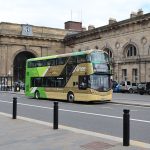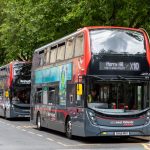Harry Blundred, the man responsible for acceptance of the minibus into the mainstream stage carriage industry, died in Barbados on 23 August 2017 following complications from surgery. He was 75.
Mr Blundred is credited with creating the minibus revolution that spread across the bus industry in the 1980s. As Chairman and Managing Director of bus operator Devon General, he introduced 16-seat Ford Transits in Torbay, later revealing that they increased ridership by up to three times and massively reduced running costs.
He later took minibuses to Oxford and London, in both instances butting heads with the powers-that-be. Mr Blundred was a staunch capitalist, and he was fiercely critical of control of, and interference in, buses by the authorities.
“We thought that the Transport Act 1985 would deregulate buses. Far from it; the rules are stricter now than they were before in terms of timescale, and I shall be writing to Transport Minister Michael Portillo asking for an urgent change in the law to free operators from unnecessary bureaucracy,” he said after encountering a rigid refusal to waver from bus registration periods in 1988.
Harry Blundred was born in Stoke-on-Trent on 19 September 1941 and after completing his education in London he returned home to the Potteries Motor Traction Company to work as a bus conductor. Ironically, his first employer later became a significant player in the minibus industry, converting hundreds for both its own fleet and others.
He later settled at Devon General before selling his British interests and moving to Australia, where he founded a transport operation. He later retired to Barbados.
During the early days of minibuses, he took pleasure in pointing out their success to critics; not only did minibuses grow passenger numbers, but the Transits proved to be remarkable durable. Although some detractors suggested that 15 months’ service would be beyond them, Mr Blundred depreciated the Fords over five years and many managed much longer lives.
Although the attractiveness of minibuses began to wane during the early 1990s as driver shortages bit and operating costs rose, they have recently returned to prominence as a tool to do what Mr Blundred envisaged over three decades ago: Increase passenger numbers and provide a real alternative to the car.
























